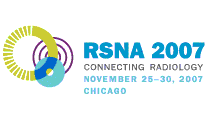
Abstract Archives of the RSNA, 2007
LL-PH6115-B05
Use of Spiral Scan Acquisitions for CT Dose Measurements: Selection of Optimal Pitch Values to Ensure Reproducible Results
Scientific Posters
Presented on November 25, 2007
Presented as part of LL-PH-B: Physics - CT
Thomas J. Vrieze RT(R), Presenter: Nothing to Disclose
John A. Bauhs PhD, Abstract Co-Author: Research funded, RTI Electronics AB, Gothenburg, Sweden
Cynthia H. McCollough PhD, Abstract Co-Author: Research grant, Siemens AG
Research grant, RTI Electronics AB
To produce a uniform dose distribution at the periphery of a CTDI phantom to allow reproducible dose measurements using small dosimeters
Radiation dose profiles and CTDI-100 can be measured using spiral scan modes and a small dosimeter (e.g. < 2 cm long). Because the dose at the periphery of an object varies as the phantom is moved through the scan plane, poor reproducibility in peripheral dose measurements can occur. Use of pitch=1 does not guarantee a uniform dose distribution. To determine the pitch value which does provide a uniform distribution (target pitch value), we adjust for the difference between nominal and actual beam width and the geometric magnification difference between isocenter and the peripheral measurement location. Dividing the target pitch value by an integer produces additional target pitches. Any other pitch value will produce less uniform dose distributions and less repeatable peripheral measurements. We tested our hypothesis using target and intermediate pitch values by measuring the dose distribution along the z-axis at the periphery measurement location using radiographic film and OSL CT probes (Landauer). At each pitch tested, the repeatability of dose measurements was determined using a very small (0.2 mm) solid-state detector (CT-SD16, RTI).
For nominal beam collimations of 3.6, 6.0, 19.2, and 28.8 mm and a 16-cm CTDI phantom, we predicted target pitch values of 1.67, 0.99, 1.07, and 1.00, respectively. For a 32-cm CTDI phantom, the target pitch values were 1.41, 0.81, 0.97, and 0.84, respectively. Radiographic and OSL measurements of the dose distribution demonstrated a very uniform dose distribution using the target pitch values. At intermediate pitch values, significant non-uniformity was observed. The coefficient of variation for the small-dosimeter measurements was 2-4% for target pitch values and > 12% for intermediate pitch values.
Geometric considerations allow adaptation of spiral pitch value such that a uniform dose distribution can be produced at the periphery of an attenuating object.
CT dose measurements may be performed using spiral scan modes with acceptable reproducibility if an appropriate pitch value is used.
Vrieze, T,
Bauhs, J,
McCollough, C,
Use of Spiral Scan Acquisitions for CT Dose Measurements: Selection of Optimal Pitch Values to Ensure Reproducible Results. Radiological Society of North America 2007 Scientific Assembly and Annual Meeting, November 25 - November 30, 2007 ,Chicago IL.
http://archive.rsna.org/2007/5009803.html

